| Something in the air
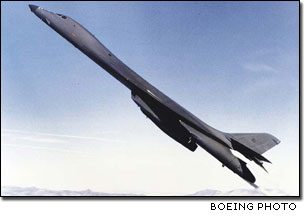 Just as successful business owners must continuously adapt to economic
changes, the U.S. Air Force (along with the rest of the military) is
rapidly transforming itself to adapt to profound changes in modern warfare.
In a post–Cold War security environment—and particularly
since the 2001 terrorist attacks in the United States—the Air Force's
challenge is how to maintain broad and sustained advantages over potential
adversaries that are becoming more amorphous. Just as successful business owners must continuously adapt to economic
changes, the U.S. Air Force (along with the rest of the military) is
rapidly transforming itself to adapt to profound changes in modern warfare.
In a post–Cold War security environment—and particularly
since the 2001 terrorist attacks in the United States—the Air Force's
challenge is how to maintain broad and sustained advantages over potential
adversaries that are becoming more amorphous.
In step with this transformation, the Air Force Systems business unit of
Boeing Integrated Defense Systems is delivering enhanced platforms and
new capabilities-driven solutions to fulfill the priorities of the U.S.
Air Force.
FULL STORY >>

The art of delivery
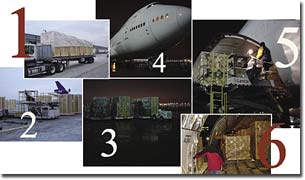 This is the story of a 60-ton trainer, a 7,300-mile (11,700-kilometer)
journey and immeasurable tender loving care. This is the story of a 60-ton trainer, a 7,300-mile (11,700-kilometer)
journey and immeasurable tender loving care.
Today, U.S. Air Force pilots at Kadena Air Base in Okinawa, Japan, train
in the F-15C Mission Training Center. The Boeing Training Systems & Services
group, part of Integrated Defense Systems, developed, programmed and
manufactured the trainers in St. Louis. The trainer, scheduled to have
been activated in late April, allows up to four pilots to train at one
time. Using a 360-degree visual display system, pilots practice takeoffs,
landings, normal ground and in-flight operations, electronic warfare,
air-to-air weapons employment and air-combat maneuvering.
FULL STORY >>

Set to sail
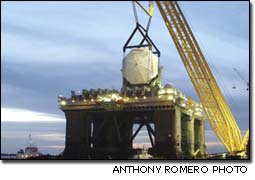 The Boeing-led Sea-Based X-Band Radar industry team is moving toward
sea trials after completing integration last month of the SBX radar with
the massive, sea-going SBX platform. The Boeing-led Sea-Based X-Band Radar industry team is moving toward
sea trials after completing integration last month of the SBX radar with
the massive, sea-going SBX platform.
SBX, a key element of the Missile Defense Agency's Ground-based Midcourse
Defense program, consists of an advanced radar system mounted on a converted
oil industry platform. SBX will be able to track, discriminate and assess
long-range ballistic missile threats.
FULL STORY >>

Still buzzing
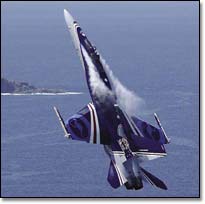 On Oct. 20, 1981, Sir James Killen, then defense minister of Australia,
heralded a new era in Australian defense when he announced to Federal
Parliament, "The government has selected, as Australia's new tactical
fighter, the F/A-18." On Oct. 20, 1981, Sir James Killen, then defense minister of Australia,
heralded a new era in Australian defense when he announced to Federal
Parliament, "The government has selected, as Australia's new tactical
fighter, the F/A-18."
Hornets were selected as the replacement for the Royal Australian Air
Force (RAAF) Dassault Mirage IIIO fighter. At the time, the program was
one of the largest and most important peacetime defense acquisitions
in Australian history, valued then at 2.79 billion American dollars.
The order, for 75 Hornets—57 single-seat A models and 18 two-seat
B models—was to provide Australia with an unmatched regional air
defense capability. It would also give the RAAF a leap forward in technology,
flexibility and versatility.
FULL STORY >>

Here's how it works
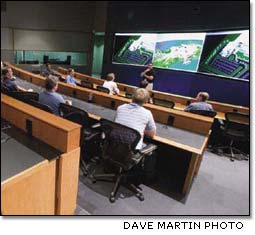 This month's debut of the new Virtual Warfare Center in St. Louis takes
Boeing and its U.S. Department of Defense customers to greater heights
in shaping future warfare capabilities. This month's debut of the new Virtual Warfare Center in St. Louis takes
Boeing and its U.S. Department of Defense customers to greater heights
in shaping future warfare capabilities.
The three-story, 70,000-square-foot center was designed to conduct complex
military mission simulations in a collaborative, network-centric environment.
Operators—including commanders, warfighters, and software and systems
analysts—rely on the center to test and challenge new technologies,
tactics and human behavior via real-time scenarios. From the collected
data and intelligence, they can better understand and prepare for live
operations—and make more cost-effective business decisions before
committing dollars and resources.
FULL
STORY>>

Exactly positioned
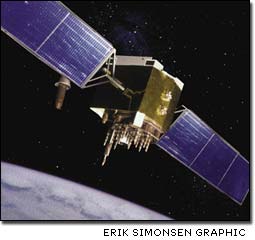 It
all began on Feb. 22, 1978, when an Atlas F rocket launch placed the
Pathfinder GPS (Global Positioning System) Navstar Block I satellite
in orbit. Since then the GPS program has evolved; today, its capabilities
have far exceeded anyone's expectations. It
all began on Feb. 22, 1978, when an Atlas F rocket launch placed the
Pathfinder GPS (Global Positioning System) Navstar Block I satellite
in orbit. Since then the GPS program has evolved; today, its capabilities
have far exceeded anyone's expectations.
Boeing has played a major role in the development and operation of the
GPS constellation and is working on the next generation of GPS.
Originally intended for military navigation and precise timing use,
GPS has become routine on commercial airliners, cruise ships and cars.
It's used by hikers, and it even monitors the earth's fault lines.
FULL STORY >>
|

